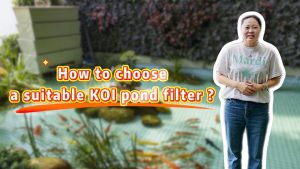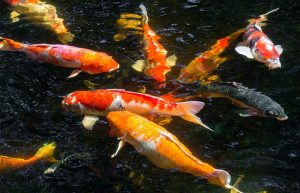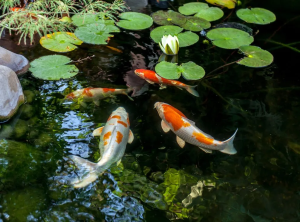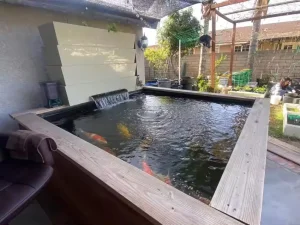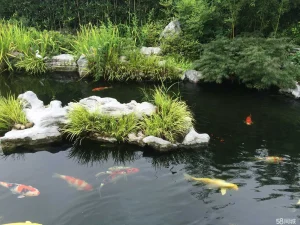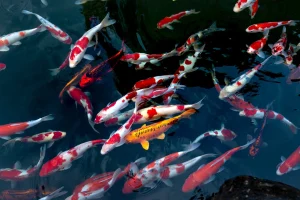Description and Function of the RDF
The Rotary Drum Filter (RDF) is a mechanical filter that removes waste and other fine particles are removed from the pond water by means of a micro screen (strainer). what makes the RDF special is its ability to ‘monitor’ changes in the water level and ‘recognise’ if the microscreen needs to be cleaned.
The micro-screens need cleaning. As a result, the rotary drum filter automatically adapts to the waste inlet and is only flushed when necessary. Another big advantage of the RDF is that all debris such as fish faeces, sand, uneaten koi food etc, is not left in the pond water. Instead, all waste is automatically flushed out of the water column in a very short period of time in a very short period of time.


How RDF Works
The (contaminated) water enters the RDF through the water inlet (1). the water flowsinto the collection chamber (3) and from there into the interior of the filter drum (4). Thefilter drum has a fine filter screen (standard 75 micron/200 mesh).
The (contaminated) water can only leave the drum by passing through the filter. All particles larger than 75 microns remain inside the filter drum, Mechanically clean water leaves the chamber of the drum filter through the water outlet (5) and can then enter the following filter state. The waste particles trapped inside the drum slowly clog the filter,making it more difficult for water to pass through it.
As a result, the water level in the clean water chamber (10) will slowly drop. Once the water level reaches a certain minimum level, which can be manually adjusted by a sensor (2) attached to the RDF, the digital control unit initiates the rinsing process.During the flushing process, the filter drum (4) is rotated by a gear motor (6) while the pump (13) runs to create high pressure water from the clean water chamber (10), then through the Y-type filtration (14), which is sprayed outside the drum by multiple spray nozzles (8).
Waste particles clogging the screen are flushed into the waste tray (9) located inside the filter drum and leave the filter through the sewage outlet (7). The water level difference during flushing can be set manually by a sensor located outside the filter.
When you need to maintain the chamber, you can use the outlet (11) to drain all the water from the Collecting chamber, and similarly, the outlet (12) to drain all the water from the Clean Water chamber.
Before install
1.As the RDF in running model will be filed with water, it is important that it is placed on aflat surface supporting the rotary drum filter.

2. Before RDF operation, please make sure there is more than one-third water inside the RD ftank to ensure the backwash pump does not idle.
3. Check the health of the backwash nozzle, whether there is debris clogged in the nozzle and whether the screws are slack.
4. Note! Electrical shock hazard
Always switch off the current to the system before coming into contact with the pond water.
Secure the system to prevent it from unintentionally being switched on.
Never connect the system to a power supply that is fitted with a dimmer.
Do not use the system in combination with a switch that has a timer function.
Only switch on the control box if the pump is below the water level and the electrodes are below the surface.
Pump-Fed System
Place your drum filter on a solid surface that is completely level.You can then connect the inlet pipe from your pump, followed by the outlet pipes.The water will be pumped into the filter by the pump. Exits that are not used must be sealed.
In pump-fed systems, a T-tube must be connected to the outlet to keep more than one-third of the water in the microfilter.
In this case, you will need to assemble the float upside for the drum section (at the inlet)collection chamber.
If the float is in the lowest position, the system is in standby. lf the float is in highest position (float is floating) then the process will commence (drum will start rotating and the rinse pump will spray-clean the screen). This will last for 9 seconds (standard value)


Gravitation System
Your Drum Filter will perform equally well in a Gravitation set-up with a few minor modifications.Place the drum filter on a solid surface that is completely level. Set the drum so the top of the max level line is even with the static water level of the pond (pump off.
By setting the water level at this height you use the most surface area of the screen in the drum filter.
You can then connect the inlet pipe (bottom drain) of the pond, followed by the outlet pipe.The outlet pipe can be connected directly to the pump. lt is recommended to set a stop valve on the inlet and outlet pipes. Depending on your setup, you can use a check valve instead of a valve on the outlet side.
For installation on gravity-basis, sufficient water feed is very important for proper functioning of the filter!
There is a risk of the rinse pump running dry and a very frequent activation of the rinse cycle if there is insufficient water supply, due to an incorrectly installed system.



